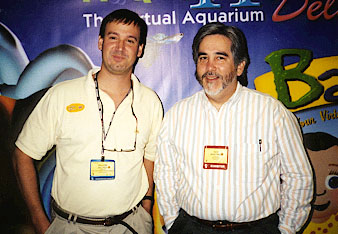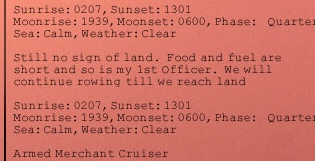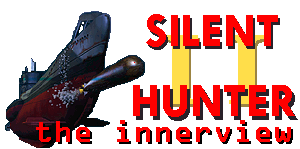Silent Hunter II Innerview: with Rick Martinez, Senior
Producer
Part I: The timing issue
SUBSIM Review: I’m sure
you’ve heard the questions—when will Silent Hunter II be ready,
when will it hit the shelf, why is it being pushed back.
Rick Martinez: First I’d like to clear the air
about why the game is delayed. I don’t think we’ve done a good job of getting
the message across. It took longer than we thought to build the team. We’re not just
going out and getting bodies off the street, we need qualified people to keep the standard
up that Bill (Becker, lead programmer) set with Silent Hunter I. It took
three times as long as we thought to get the right people in the right places, especially
in regards to 3-D and the other game improvements.
We’re signed officially to get this game out at the end of the
summer, or the fall, before the end of 2000, whatever it takes to do it right. The
milestones and the look of the game are really good. Aeon has been doing really good work.
Bill built up Aeon and has assembled a talented team. The first game took three plus
years, much longer than Silent Hunter II, even with the delays. Most of the first sim was
done by two people, Bill Becker did the programming and Kim Biscoe did
the artwork. And let’s face it, without Kim’s artwork, the sim wouldn’t
have stayed as shelf-worthy as it did. The game stayed good-looking for longer than most
games do because he did such a good job.
 |
Bill Becker (Aeon), Rick Martinez (SSI) |
But basically they’re where they should be now and the
sim’s meeting its milestones well. I feel it’s important for people to be aware
of this.
SSR: I know players are impatient but I’ve
read a lot of posts on bulletin boards and newsgroups, like Paul Powell,
for example, who’ll say, "I just want to see it done right, I can wait".
RM: We were very fortunate, in a sense, when we did
Silent Hunter I. We were a small company, SSI, loved doing wargames and sims our way. If
not for this Silent Hunter would have never gotten built. It’s like the Aces
of the Deep story—these kinds of sims and games are not slam-dunks.
SSR: It has to be a labor of love—you need to
be interested in making that sim.
RM: Yeah. Silent Hunter sold so well over the
years, that there was a good reason, economically, to do another one. The sales volume
allowed us to convince the legals and accountants that it was a good investment. We have
to justify it, and you know what, I don't blame them. It’s real money.
Silent Hunter sold worldwide, around 300,000 copies,
or a little more. It outsold Aces of the Deep on a two-to-one scale. Now since I think the
Atlantic and the U-boats are a more romanticized and fun theater, most people you talk to
think wolfpacks are cooler than the Pacific theater. Now you can see the basis for my
enthusiasm for Silent Hunter II—if I’ve got a game that outsold the game that
was one of the best made—Aces of the Deep is just a fine product—I can show this
to the investors and say, "Hey, look, Silent Hunter II can’t be less successful
that the original." The way Silent Hunter I was put together, it continued to sell
long after Windows 95 became the predominant OS. People found a way to make it work on
their desktop.
| What
we’re trying to do is take a good product and make a better one. That in itself is a
bigger challenge than most people not involved in making games know. |
SSR: So, the new version of Silent Hunter will
follow in the footsteps of the original, set in the Atlantic.
RM: What your going to find with the new sim, in a
nutshell, is we’re not trying to reinvent the wheel. I know that may upset some
people, they want to have crewmen running up and down, I know all that, ad nausea, I know
the expectations. What we’re trying to do is take a good product and make a better
one. By improving the things we wanted to do on the first one, and we have a 3-D world
now, which is a whole separate issue in itself. We want to make what was excellent even
better. That in itself is a bigger challenge than most people not involved in making games
know.
SSR: This is going to be a Windows environment
game, correct?
RM: Of course, yes.

|
View through the deck gun |
SSR: That’s a big step in itself. There are a
lot of players, newer computer users, who have no DOS background, who aren’t familiar
with boot disks and don’t want to mess around with their config.sys files. A Windows
based version of Silent Hunter II will be a boon for many players who will be able to play
it, whereas with a DOS version they can’t.
RM: Yes, it’s frustrating, they can’t
launch it from the desktop, it’s tough. There’s more to it than that, though. We
wanted to take it up a step. You know, in the original, we had multimedia that for the
time was pretty good, the interviews and sub tour. Well, on Silent Hunter II we decided
not to handle it internally. We can do a decent job but it’s still somewhat limited
by internal resources. We went to Lou Reda Productions. They do a lot of
the documentaries on The History Channel and A&E, Patton and hour-long specials (Lou
Reda Productions has produced more than 200 specials for network and cable television,
including the CBS miniseries The Blue and the Gray; A&E biographies of Norman
Rockwell, George Patton, and Milton Hershey; and The Doomsday Flu: Killer Epidemic of
1918. – ed.). We’re going to package it where it can accessed from the CD.
Their multimedia people have been doing this for years successfully on television.
There’s a major difference right there.
Instead of one captain to interview, we have several U-boat aces. Erich
Topp is featured and we have interviews with lots of crewmembers as well.
The sub tour is already done. You have the ability to jump down the
hatch and look around using the mouse and view a seamless scene of the interior of the
U-boat. We used a special technology that employs realview photography. You can look
around and zoom in and out, focus on individual fittings, look toward the hatch, click on
it and move into the next compartment.
We toured two U-boats in Germany, one being the only Type VII in the
world, and the Type IX in Chicago, researching the layout and lighting. I think
you’ll find the multimedia in Silent Hunter II is a huge improvement over the
original.
| With
Silent Hunter II we are going to give them more, to make the gameplay to suit their taste
or to make it as realistic as they can stand it. |
SSR: Describe the way you have crafted the
interiors of the U-boats in Silent Hunter II.
RM: We using as the Type VII as the basic interior
model. The exteriors will be exact replicas of each class of U-boat. We may have to fudge
a little on the interiors to keep the basic functionality intact. But when the player goes
in the different places they will get the feeling of being in a U-boat.
SSR: I sat in on an Internet chat last year you
hosted. I listened to the questions the players hit you with, all the wish list items such
as crewmen manning stations, merchant ships carrying lumber that would resist sinking, men
overboard situations, weather effects, etc.—pretty much everything needs to be done
to make everyone happy—and that can’t be done.
RM: Yes, a lot of people seem to think it’s
magic—and there is an element of magic in it. It’s magic to play it but putting
it together is hard work. And you have to understand that we can’t do everything or
we’ll have nothing.
I don’t think the public at large understands how it stings
someone working the hundreds of hours these guys work overtime—the sweat!—to
hear them say about a game that’s not even out, those horrible things. They think we
all jump around in BMW’s and go to little meetings and stuff. It’s not like
that. It’s hard work. It’s fun and rewarding but it’s still hard work.
It’s funny. The head of Aeon has taken down every one of these
wish lists and he has got a large number of things players have asked for in the game
already. The things he can’t do are create DOOM inside the sub. There was a
debate on the Silent Hunter II forum the other day about having watch officers smoking
cigarettes, different modes of readiness…. It gets crazy!
Luckily now there are people getting on and countering these ideas
with common sense observations. It’s really helpful. The job is to give as much
control over detail through the options, yet making it as simple through the options as
they want it to be. When Silent Hunter came out we gave the player a lot of choices and
with Silent Hunter II we are going to give them more, to make the gameplay to suit their
taste or to make it as realistic as they can stand it.

|
Sample of the typical log entries |
Here’s an example: you know how the torpedo launching used to
work. You could allow the computer to do it in automatic or you could switch to manual and
calculate the mast height from the ID book and Stadimeter, angle on the bow, all that
stuff. This sim has the same feature. You can go nuts and try to do everything in manual
if you want or let the computer handle it. Now what we’ve done is added a little
level that we think is fun. You can control the set-up and flooding of the tubes. You have
a two-screen interface to set up your torpedo stuff. You select from the different torpedo
types as before, you load them, flood the tubes, open the outer doors; all those little
steps can be done automatically or you can do them yourself.
People have asked about different kinds of missions and yes,
we’re going to have many different kinds of missions. You know, it gets pretty boring
to be only rescuing pilots, for instance. They’ll figure into it in a minor way.
Minelaying is one of the questions we get asked about. That may or may not make it. We
haven’t seen very many people who are passionate about minelaying.
SSR: Personally, that would not seem like a U-boat
Commander’s favorite assignment. He should get in the middle of a convoy.
RM: And that’s what we’re trying to do
with the sim, to make you a U-boat commander. You won’t be getting into
Heinrich’s state of mind or worrying about if Wolfgang is upset with his
sweetheart—you’re supposed to be the Man.
Return to SUBSIM Review
©2000 SUBSIM Review




